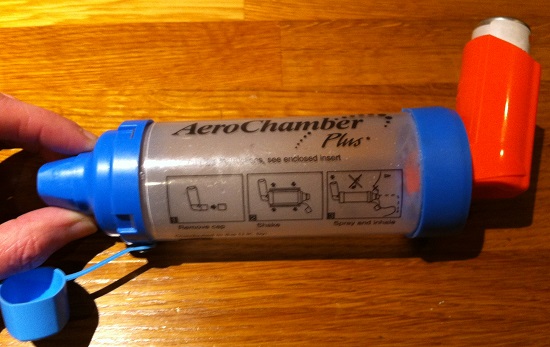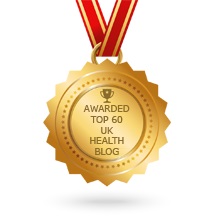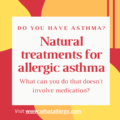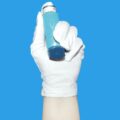This is a really quick blog about inhalers.

If you’ve got asthma make sure you do these ten things to stay safe and up-to-date with the latest thinking. I always learn something when I have an asthma review.
- Is your inhaler in date? – This might sound obvious but sometimes they can hang around in the back of a drawer, in a sports bag or wash bag. Make sure you check the expiry date and renew them when they are out of date.
- Do you ‘shake it’ before puffing? – This is something I sometimes do and sometimes not but I never really thought about why. The reason you should shake it is to make sure the drug is fully distributed inside the inhaler. It can sink to the bottom, especially when the canister is not full. By shaking it you make sure you get a full dose each time.
- Are you using it properly? – To get the proper dose safely, use the spacer or aero chamber, press the inhaler and then breath in and out normally to slowly breathe in the dose. If you’re not using a spacer, hole the mouthpiece between your teeth and seal with you lips. Breathe out slowly and as you breath in, press the inhaler so that a puff of the drug is expelled into your mouth. Continue to breathe in slowly and then close your mouth for a few seconds when you remove the inhaler. This is to ensure you don’t just lose the drug by stopping to soon or just breathing it straight back out.
- Always use a spacer with your preventative inhaler – The steroids in your preventative inhaler can cause thrush or a yeast infection at the back of your mouth. Using a spacer inhaler can really help to prevent the drug being blasted straight at the back of your throat. You shake the inhaler, press to expel the pass and then breath in slowly and evening about 6-8 times to take the drug slowly into your system. If you don’t have one already speak to your doctor or asthma nurse to get one on your repeat prescription. You can also buy them on Amazon. AERO CHAMBER PLUS
- Do you gargle after inhaling? – It might not be enough just to drink water or brush your teeth after using your inhaler. Try gargling and spitting out the water at least 2 or 3 times after taking your inhaler. This should mean any of the drug that has been blasted onto the back of your throat is washed off, leaving the drug to do it’s work in your lungs.
- Use regularly – Don’t forget to take your preventative inhaler as this can seriously reduce the effectiveness of the drug. If you are worried it isn’t working, make an appointment with the asthma nurse. If your peak flow is worsening this could be due to you forgetting to take it or you may need to take an extra puff for a while.
- Your adrenaline could save your life in an asthma attack – if you’re having a very bad asthma attack and your inhaler isn’t working adrenaline would definitely help. Asthma is an immune response and is often caused to allergy triggers. If you carry adrenaline anyway and are scared your asthma is out of control, your adrenaline injector could save your life. If you can’t get help or an ambulance hasn’t arrived it would be worth a try. It won’t harm you and could just be life saving.
- Keep your asthma appointment – The NHS provision for those with asthma is actually pretty good. Asthma can be a killer and far more people die from asthma every year than from allergies. I would question whether a lot of those asthma deaths were caused by allergy triggers but this isn’t recorded. Your asthma appointment is really important. You may think it’s all under control but you may not notice small deteriorations in your health and you may also not be taking your medication correctly. You may not get allergy appointments very easily so don’t turn down these opportunities to see a professional.
- Always carry it with you – Never leave it at home. Take your inhaler with you whenever you go out.
- Get a spare – Always have two available in case you lose or misplace one.
Visit the Asthma.org website to find out more.
If you have allergies it’s vital to keep your asthma under good control. It can mean a matter of life and death if you do have a serious reaction as well controlled asthma could mean a much less severe reaction.
As well as having your inhalers, also carry adrenaline (if prescribed), anti-histamines and your Allergy Action plan. These will all help anyone who needs to give you emergency assistance and could also mean you have a less severe allergic reaction. Be prepared at all times!












My son is going to have to use an inhaler now, so I decided to look up some stuff about that. I didn’t know that you should use a spacer for any kind of preventative inhaler! Not to mention it could save your life in a bad asthma attack. I’ll have to make sure he knows that. Thanks for sharing!
Thank you you have made me check out the date on my inhalers I always have several dotted about and thought I was pretty much covered horrified to find 3 well out of date.
I do use a spacer at home but not when out because it’s a bit bulky for my handbag I didn’t know how important it was!! I have never heard of a adrenaline shots is this something my asthma nurse should have told me about
Hi Barbara, no they probably wouldn’t prescribe this unless you have anaphylaxis but it also can help in an asthma attack. Asthma medication used to be a mix of adrenaline and becatide or whatever drug it is for asthma that opens air ways. Not something your asthma nurse would probably mention
“When someone talks about ‘wrong breathing’, it means he or she doesn’t understand my discovery,” – said Dr. Konstantin Pavlovich Buteyko – “in physiology there is only the concept: the norm. The deviation from the norm is disease. Therefore we don’t talk about ‘wrong body temperature’ or ‘wrong blood pressure’ and for breathing it is exactly the same. But deep breathing is a deviation from the norm. So this is a disease.” Deep breathing causes various disturbances in the body. The body tries to compensate for these disturbances: the airways are constricted, the blood vessels are constricted, the nervous system becomes stressed, etc. It is clear that, as breathing is reduced to the norm, these adjustments are no longer necessary for the body and health is restored.
It is now a clear fact, which has been confirmed by all published studies, that development and first stages of asthma are always accompanied by hyperventilation. The situation with medical respiratory professionals and asthma was accurately reflected by Peter Kolb,
“… asthma is a disorder which is investigated by thousands of respiratory specialists with millions of dollars worth of equipment to measure breathing. Yet after more than half a century of work by all these people measuring patients’ breathing, they haven’t picked up that asthmatics are just breathing too much” (Kolb, private communication, 2001).
Clinical trial conducted at the Mater Hospital, Brisbane, Australia
Buteyko breathing techniques in asthma: a blinded randomised controlled trial.
Simon D Bowler, Amanda Green and Charles A Mitchell
The study was carried out from January 1995 to April 1995.
Buteyko group:
Bronchodilators after 3 months: 96% less
Inhaled steroids after 3 months 49% less
Reduction of symptom scores after 3 months: 71%
Control group:
Bronchodilators after 3 months: 7% less
Inhaled steroids after 3 months: remained the same
Reduction of symptom scores after 3 months: 14%
On the 2 pages below you can read how to do the Buteyko breathing normalization exercises:
Marina Buteyko, Vladimir Buteyko
THE FIRST-HAND BUTEYKO METHOD:
https://www.buteyko.ru/izdan/first_hand_buteyko_method.doc
Search also for Getting Started with the Buteyko Method by Peter Kolb:
Biochemical analysis of Buteyko’s Method by Karzimov
For those with a highly technical interest, this biochemical analysis of Buteyko’s Method by Karzimov is both an extraordinary piece of technical work as well as being a highly detailed explanation of mechanisms around how and why the method works.
https://f52aaf98-af2c-4da9-98d1-3635fdc552f3.filesusr.com/ugd/37b13a_92e6561893754a4f98c6ce30f3d272f8.pdf
Really Helpful Thank You